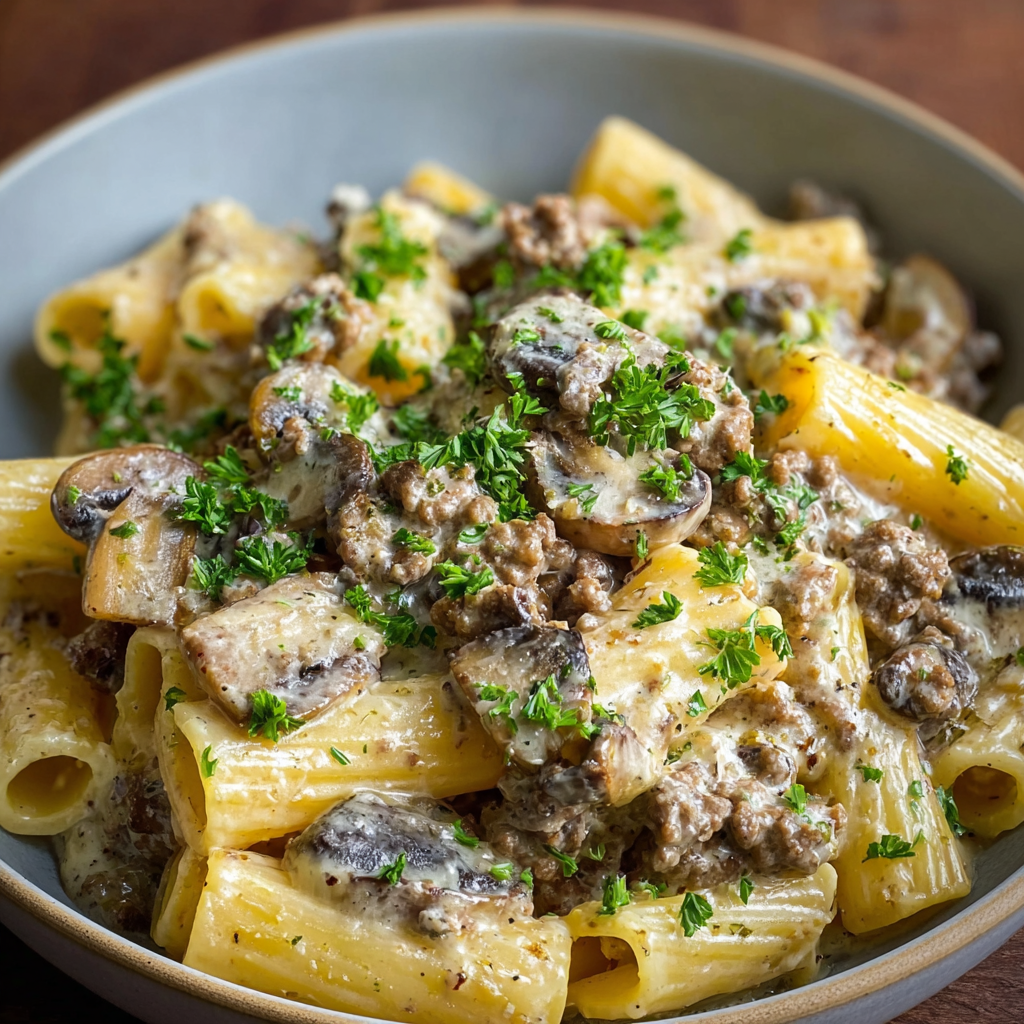Philly Cheesesteak Pasta
1. Introduction to the Recipe
If you love the classic flavors of a Philly cheesesteak but want a comforting, easy dinner twist, Philly Cheesesteak Pasta is the perfect recipe to try. This dish combines tender, thinly sliced ribeye or sirloin steak with sautéed green peppers, onions, and garlic, tossed into al dente penne or rigatoni pasta and smothered in a creamy blend of provolone and mozzarella cheeses. It’s a crowd-pleasing meal that captures all the iconic cheesesteak flavors in a delicious, hearty pasta dish.
What makes this recipe especially appealing is its simplicity and versatility. Whether you’re feeding a family on a busy weeknight or hosting friends for a casual dinner, this one-pot wonder comes together quickly while delivering rich, savory flavors. The addition of Worcestershire sauce and beef broth deepens the umami notes, complementing the creamy cheese sauce perfectly.
If you want to explore more about the essential ingredients or cooking techniques, check out this guide on how to cook the perfect steak and this ultimate pasta cooking tips article.
Whether you’re craving cheesesteak-inspired comfort food or looking to elevate your pasta game with a unique spin, Philly Cheesesteak Pasta hits all the right notes — meaty, cheesy, and irresistibly satisfying.
2. Basic Recipe: Ingredients and Instructions
Print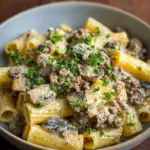
Philly Cheesesteak Pasta – Creamy, Cheesy, One-Pot Dinner
Description
Creamy Philly Cheesesteak Pasta made with steak, cheese, peppers, and onions—a delicious one-pot twist on the classic sandwich!
Ingredients
-
1 lb ribeye or sirloin steak, thinly sliced (or shaved beef)
-
12 oz penne or rigatoni pasta
-
1 green bell pepper, diced
-
1 yellow onion, diced
-
2 cloves garlic, minced
-
1 cup beef broth
-
1 tbsp Worcestershire sauce
-
6 slices provolone cheese, chopped
-
1 cup shredded mozzarella cheese
-
1 tbsp olive oil
-
Salt, to taste
-
Black pepper, to taste
Instructions
Cook the pasta in a large pot of salted boiling water according to package instructions until al dente. Drain and set aside.
Heat olive oil in a large skillet over medium-high heat. Add the sliced steak and cook for 3–5 minutes until browned but still tender. Remove the steak from the skillet and set aside.
In the same skillet, add diced onions and green bell peppers. Sauté for 4–5 minutes until softened.
Add minced garlic and cook for another 1 minute until fragrant.
Pour in beef broth and Worcestershire sauce, stirring to deglaze the pan and scrape up any browned bits.
Reduce heat to medium-low and add chopped provolone cheese, stirring until melted and incorporated into a creamy sauce.
Return the cooked steak to the skillet, season with salt and black pepper to taste, and combine with the sauce.
Add the cooked pasta to the skillet and toss well to coat evenly with the cheese and beef mixture.
Sprinkle shredded mozzarella cheese on top, cover the skillet, and cook for 2–3 minutes until the mozzarella melts.
Serve immediately, garnished with additional black pepper or fresh herbs if desired.
Notes
For the most tender results, slice steak thinly against the grain—freezing it for 20 minutes makes slicing easier.
Use shaved beef for a quicker, more authentic cheesesteak feel.
Cook pasta al dente so it holds up well when mixed with the sauce.
3. Advanced Techniques
Choosing the Best Cut of Steak
For optimal flavor and tenderness, use ribeye or sirloin steak thinly sliced across the grain. Ribeye provides rich marbling for juiciness, while sirloin is leaner but still tender. Avoid thicker cuts unless you plan to cook and slice them yourself. If using frozen steak, thaw it properly and slice when slightly firm for clean, thin cuts.
Perfectly Al Dente Pasta Every Time
Cooking pasta to al dente ensures the perfect bite and prevents mushiness when mixed with the sauce. Salt your pasta water generously to season the pasta internally. Reserve a cup of pasta water before draining; adding a splash can help loosen the sauce and improve coating on the noodles.
Creating a Silky Cheese Sauce
Melt the provolone slowly over low heat to prevent separation and ensure a smooth sauce. Stir continuously and avoid boiling, which can cause the cheese to become stringy or clumpy. Adding a small amount of beef broth or pasta water helps achieve the ideal sauce consistency.
Incorporating Garlic for Maximum Flavor
Add garlic after the onions and peppers have softened to prevent burning, which leads to bitterness. Mince garlic finely or use pressed garlic to disperse flavor evenly throughout the dish without overpowering other ingredients.
Melting Mozzarella Perfectly
Top the pasta with shredded mozzarella and cover immediately to trap heat and create an even melt without overcooking. Alternatively, a quick broil for 1-2 minutes gives a bubbly, golden finish, adding texture and visual appeal.
See more advanced recipes at cookingwhite.com
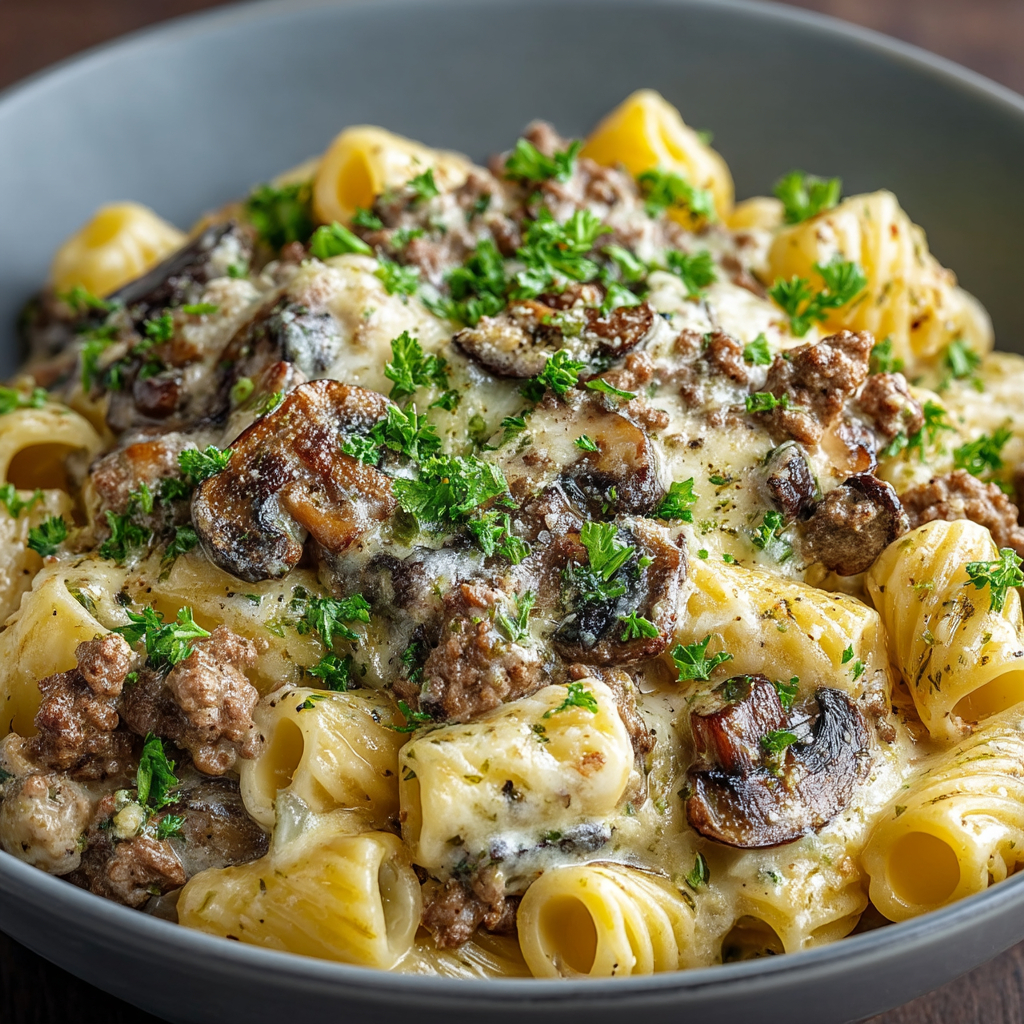
4. Storage, Shelf Life, and Maintenance Tips
Refrigerate Leftovers Promptly
Store leftover pasta in an airtight container within two hours of cooking. It will keep in the refrigerator for up to 3 days. Reheat gently to preserve texture and flavor.
Reheat Without Drying Out
You Reheat leftovers on the stovetop over low heat, adding a splash of beef broth or milk to restore creaminess. Stir frequently to prevent sticking or burning.
Freeze for Longer Storage
Philly Cheesesteak Pasta freezes well for up to 2 months. Portion into freezer-safe containers, leaving space for expansion. Thaw overnight in the fridge before reheating.
Avoid Overcooking the Pasta During Storage
To prevent soggy pasta, slightly undercook it during the initial boil if you plan to store or reheat later. This ensures it retains firmness after reheating.
Keep Cheese Fresh
Store unused provolone and mozzarella wrapped tightly in plastic or wax paper inside the fridge. Use cheese within the recommended shelf life for the best flavor and melting quality.
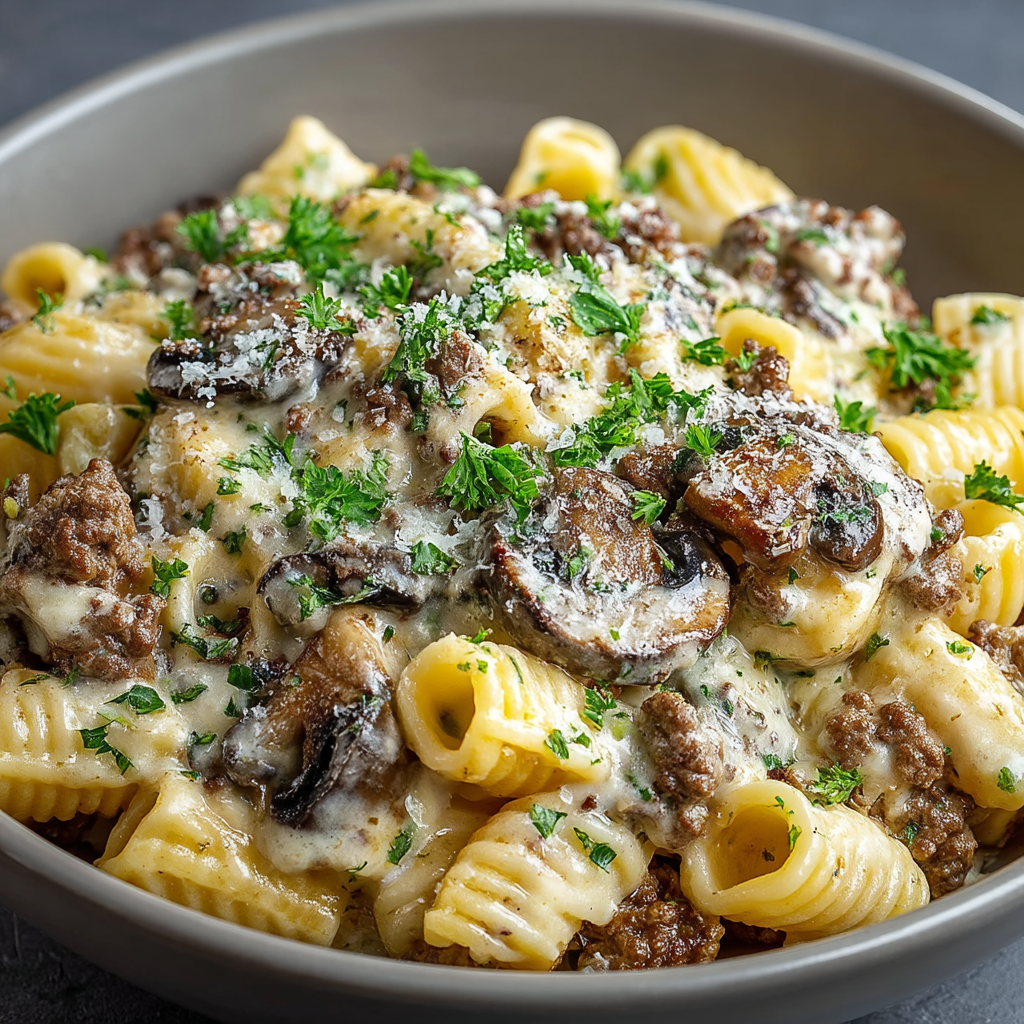
5. Dietary Adaptations and Substitutions
Use Plant-Based Meat Alternatives
For a vegetarian or vegan version, swap the steak with plant-based meat crumbles or sliced mushrooms. Use vegetable broth and vegan cheese substitutes to maintain creamy texture.
Gluten-Free Pasta Options
Substitute regular pasta with gluten-free penne or rigatoni made from rice, corn, or chickpeas. Adjust cooking times according to package instructions.
Lower Fat Version
Choose lean sirloin or ground beef with less fat. Use reduced-fat cheese or less cheese overall. Adding extra veggies like mushrooms or spinach increases volume and nutrition.
Dairy-Free Cheese Substitutes
Use vegan cheese slices and shredded cheese alternatives made from nuts or soy. Nutritional yeast can also enhance cheesy flavor without dairy.
Add More Vegetables
Incorporate additional veggies such as mushrooms, spinach, or cherry tomatoes to boost fiber, nutrients, and texture variety.

6. FAQs About the Recipe
Can I use other pasta shapes?
Yes! Any sturdy pasta like penne, rigatoni, or even fusilli works well as it holds sauce effectively. Avoid delicate pastas like angel hair which may get lost in the rich sauce.
How thin should I slice the steak?
Aim for slices about 1/8 inch thick for quick cooking and tender bites. Freeze the steak for 30 minutes beforehand to make slicing easier and neater.
What’s the best way to reheat leftovers?
Stovetop reheating with a splash of broth or water is best to maintain sauce creaminess and prevent dryness. Avoid microwaving unless using a microwave-safe cover to trap steam.
Can I prepare the sauce in advance?
Yes, prepare the cheese sauce and steak mixture ahead and refrigerate. When ready to serve, cook pasta fresh and combine everything before heating gently.
Is this recipe kid-friendly?
Definitely! The creamy cheese and tender steak are generally well-liked by kids. You can reduce pepper quantity or chop veggies finely to accommodate picky eaters.
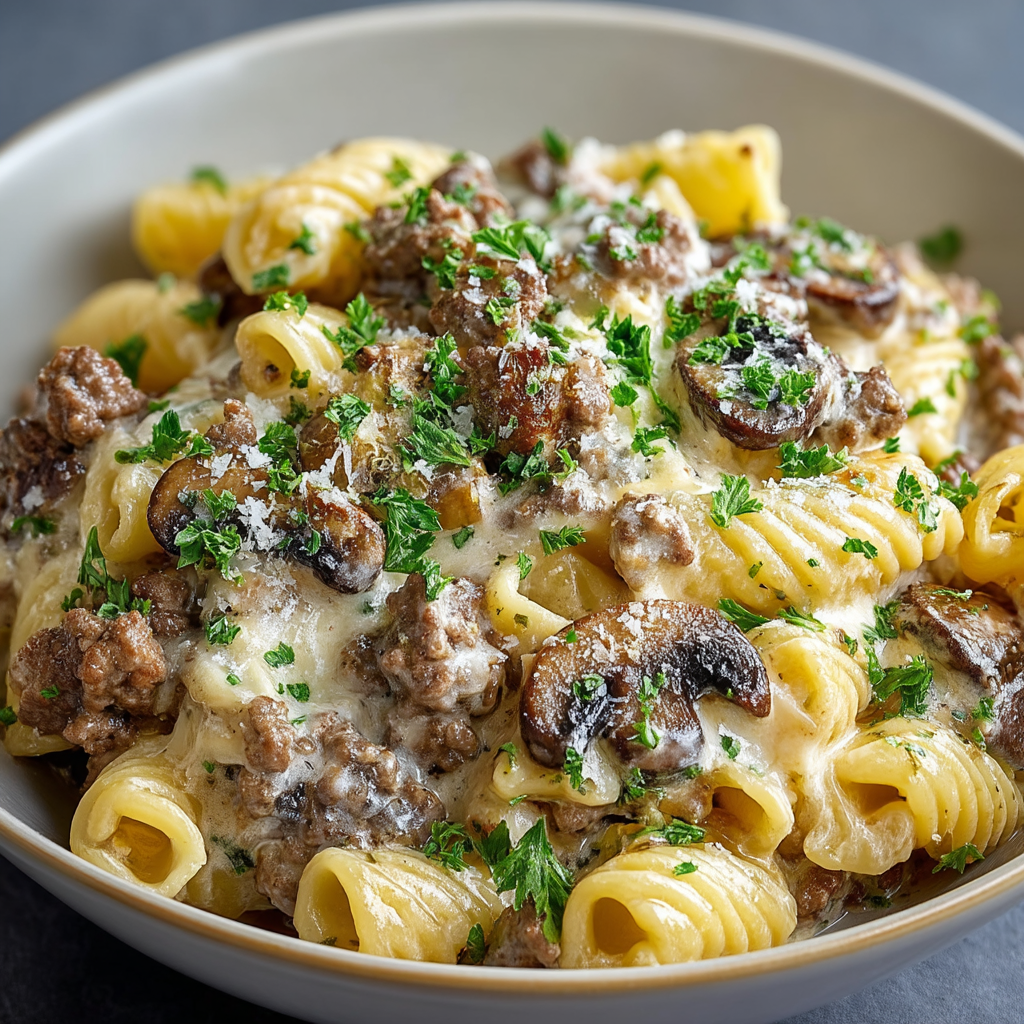
7. Conclusion & Final Thoughts
Philly Cheesesteak Pasta beautifully bridges the gap between two beloved comfort foods—Philly cheesesteak and cheesy pasta—offering a unique, hearty dish that’s quick to prepare and deeply satisfying. It takes the iconic flavors of thinly sliced steak, sweet peppers, and melty provolone cheese and wraps them into every bite of tender pasta. This recipe is perfect for busy weeknights when you want something impressive without fuss, or for casual dinner parties where you want to serve something crowd-pleasing with minimal effort.
What makes this dish especially special is its flexibility. Whether you use ribeye for rich flavor or sirloin for a leaner cut, swap pasta shapes, or adjust cheese amounts, it always delivers a luscious, cheesy meal that warms the soul. The savory depth from Worcestershire sauce and beef broth elevates the flavors beyond your typical pasta dinner.
In summary, Philly Cheesesteak Pasta is a clever and delicious way to enjoy the comfort of a Philly cheesesteak in a new form. It’s satisfying, indulgent, and versatile—making it a must-try recipe for anyone who loves bold flavors and easy dinners. Once you make it, this recipe will likely become a staple in your culinary rotation.

